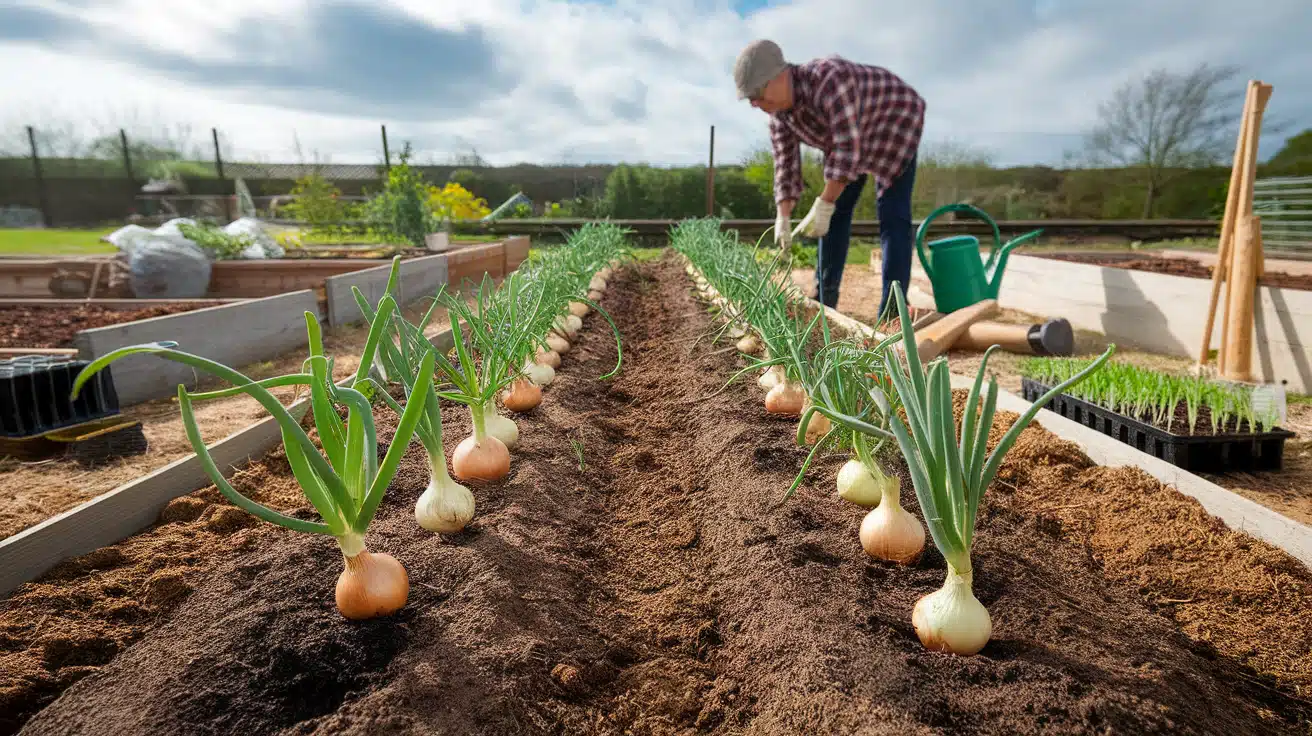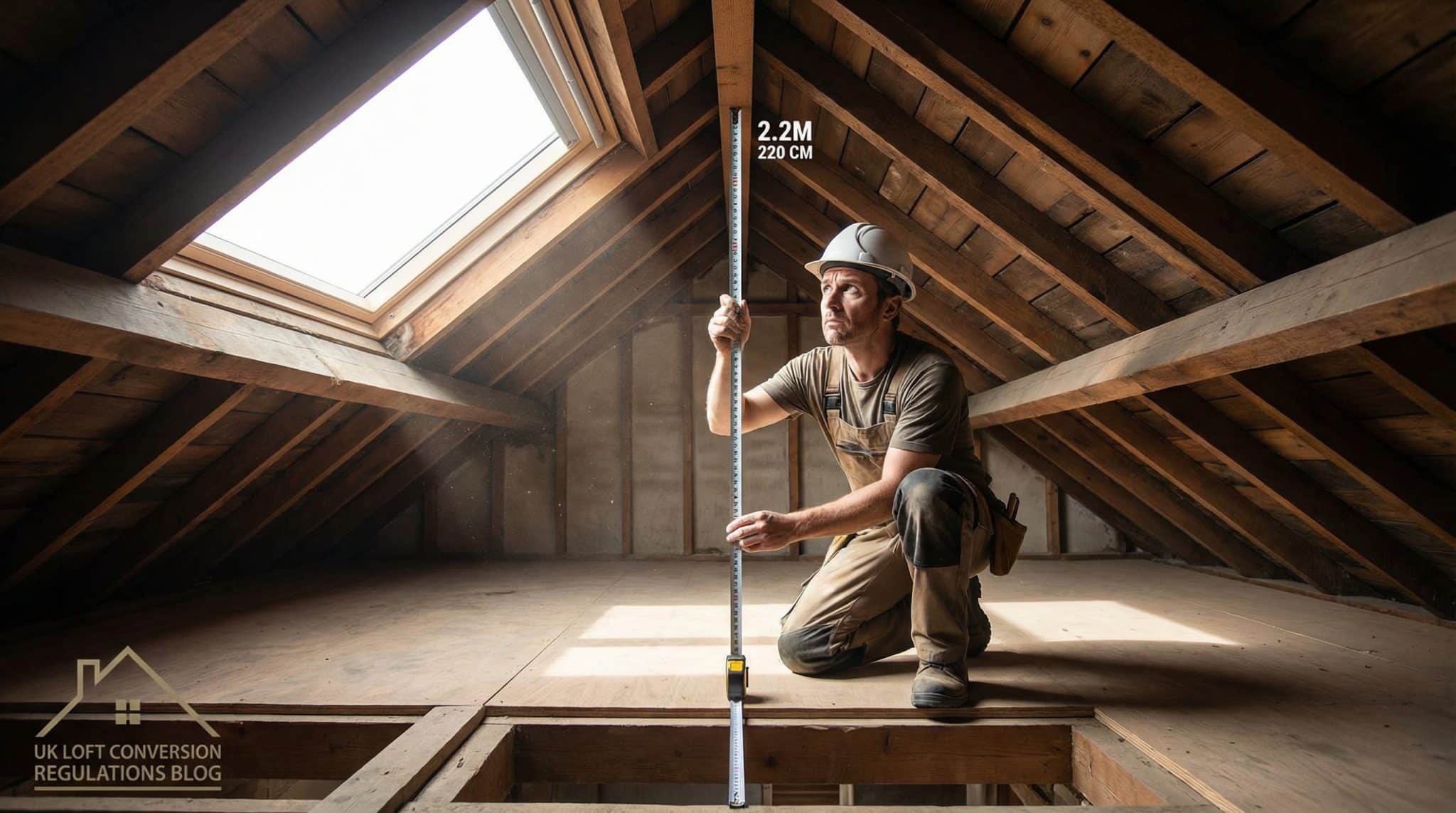Picture this: you’re in your garden, admiring rows of flawless onions you grew yourself, bulbs so perfect they’d make any gardener envious.
Most UK gardeners struggle with onions. Tiny bulbs, premature bolting, it’s frustrating. I used to be one of them. Then I cracked the code.
Here’s the truth: growing prize-winning onions in the UK is doable when you know what works.
From choosing between seeds, sets, and transplants to timing planting around unpredictable British weather, I’ve picked up every trick that separates mediocre from magnificent.
In this complete guide, I’ll share everything I wish I’d known from the start. No fluff, just the proper techniques to help you skip the trial and error and go straight to onions that grow big, taste great, and store through to next spring.
What It Takes to Grow Onions in the UK Climate?
Want to grow great onions in the UK? Just follow these three simple steps: choose the right type, plant at the right time, and prepare your soil properly.
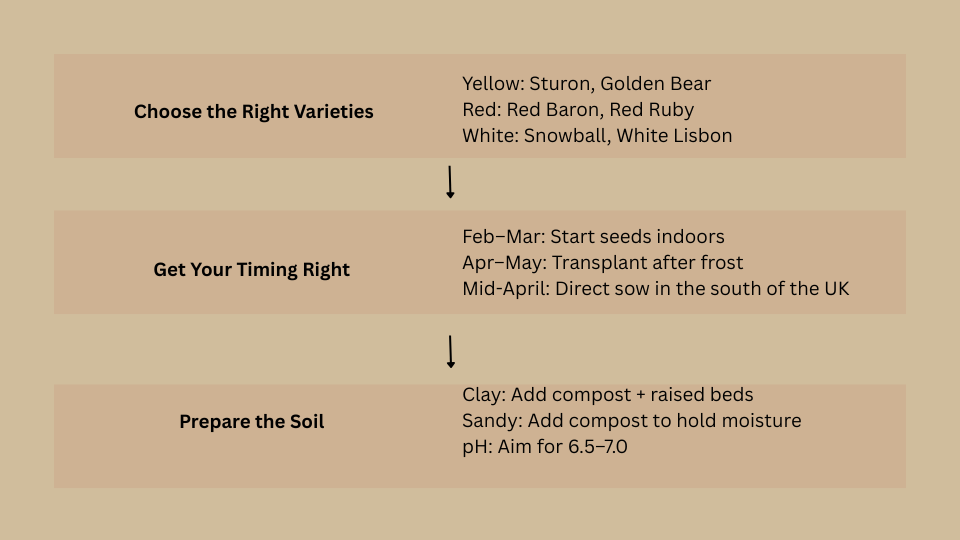
Step-by-Step Onion Growing Guide in the UK
Follow these six essential steps from site preparation and planting to harvesting and curing to grow healthy, flavorful onions with long-lasting storage in your garden.
Tools
| Tools | Purpose |
|---|---|
| Plug trays | For sowing onion seeds indoors |
| Pots | For sowing onion seeds indoors as an alternative to plug trays |
| Rake | To level the soil before direct sowing |
| Fork | To lift/harvest onions from the ground |
| Trowel | To lift/harvest onions from the ground (alternative to a fork) |
| Hoe | To weed carefully between rows |
| Racks | To space bulbs out for good airflow during drying/curing |
| Nets | To store onions after curing |
Materials
| Materials | Purpose |
|---|---|
| Onion seeds | For growing onions from scratch |
| Seed starting potting mix | To fill trays for sowing seeds |
| General-purpose potting mix | Alternative growing medium for seed sowing |
| Compost | To enrich the soil with organic matter |
| Well-rotted manure | To enrich the soil with organic matter (alternative to compost) |
| Row cover | To cover early sowings/transplants to speed growth and reduce bolting |
| Fleece | To cover early sowings/transplants to speed growth (alternative to row cover) |
| Onion transplants | Ready-to-plant seedlings for immediate planting |
| Onion sets | Part-grown onions for convenient, time-saving planting |
Step 1: Site Preparation & Soil Setup
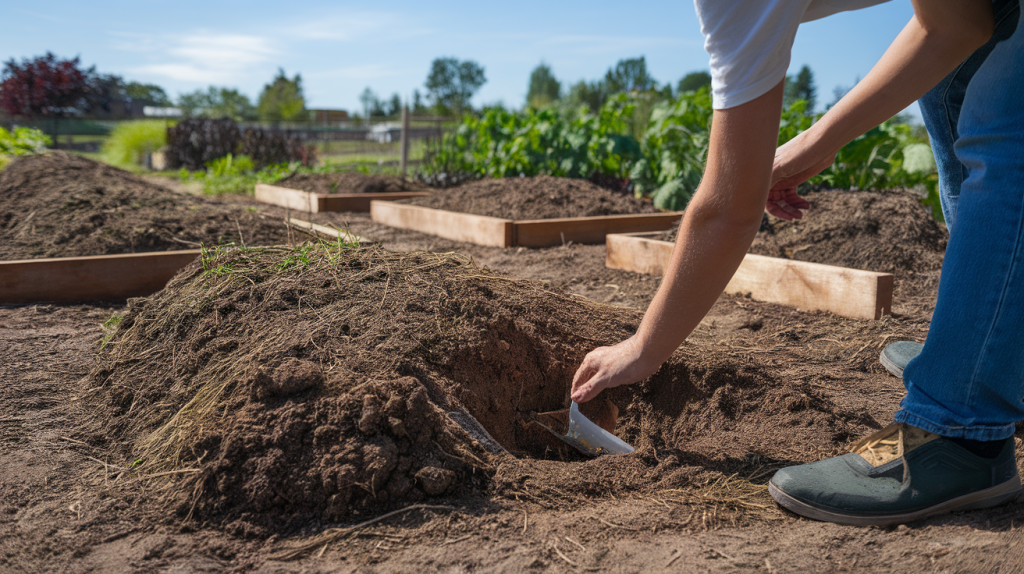
Choose a sunny, open location with well-drained soil. Enrich the soil with compost or well-rotted manure for optimal nutrition. If your soil is heavy and retains too much water, create raised beds or mounds to improve drainage.
This foundation ensures healthy root development and prevents waterlogging, which can damage onion bulbs during their growth cycle.
Pro tip: Test soil drainage by digging a hole and filling it with water if it doesn’t drain within 24 hours, raised beds are essential for onion success.
Step 2: Choose Your Starting Method

Select from three planting options: seeds (most economical, longest storage), transplants (convenient, good storage), or sets (easiest but shorter storage life).
Seeds can be started indoors in plug trays during late winter for the earliest harvest. Sets are planted directly in spring for convenience. Each method has trade-offs between effort, timing, and storage quality.
Gardener’s secret: Heat-treated sets resist bolting better than regular ones, making them ideal for unpredictable spring weather conditions.
Step 3: Sowing & Planting
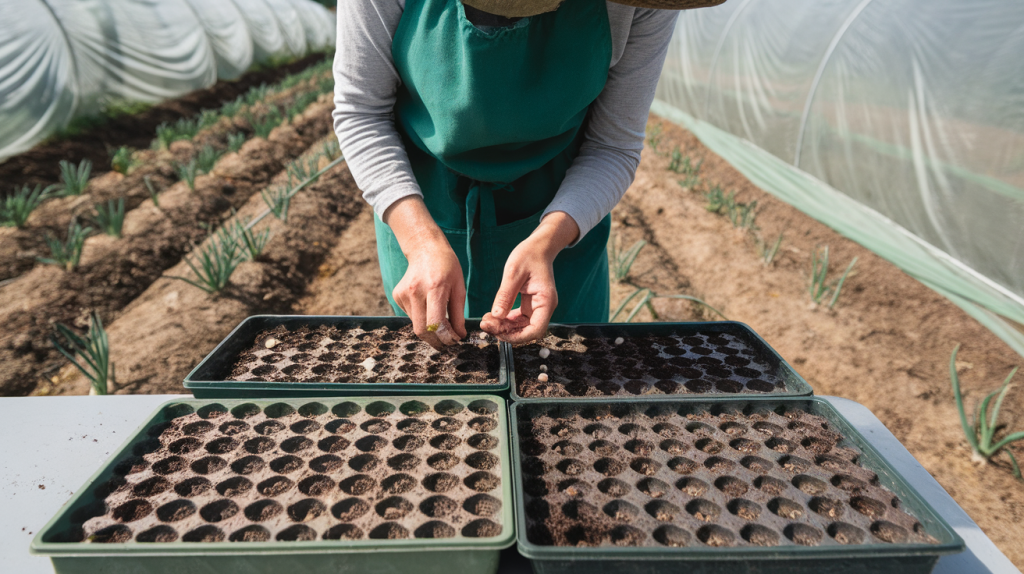
For seeds, Sow 4-8 seeds per cell in potting mix, cover with ¼-½ inch of soil, and transplant when small. For direct sowing, rake the soil to a level surface, create ½-inch deep drills 12 inches apart, and sow the seeds thinly.
For sets, plant in mid-spring with tips just showing, space 2-4 inches apart. Use row covers on early plantings to prevent bolting.
Smart technique: Plant clumps of seedlings together without separating they’ll naturally push each other apart as they grow, creating perfect spacing.
Step 4: Growing & Maintenance

Water consistently during dry periods since onions have shallow roots. Weed regularly using careful hoeing between rows and hand-weeding within rows to avoid root damage.
Thin direct-sown seedlings to 2-4 inches apart, depending on desired bulb size. The thinned seedlings can be enjoyed as green onions. Maintain weed-free conditions throughout the growing season.
Bonus harvest: Those tender thinnings make excellent scallion substitutes and add fresh onion flavor to early season salads and cooking.
Step 5: Harvesting
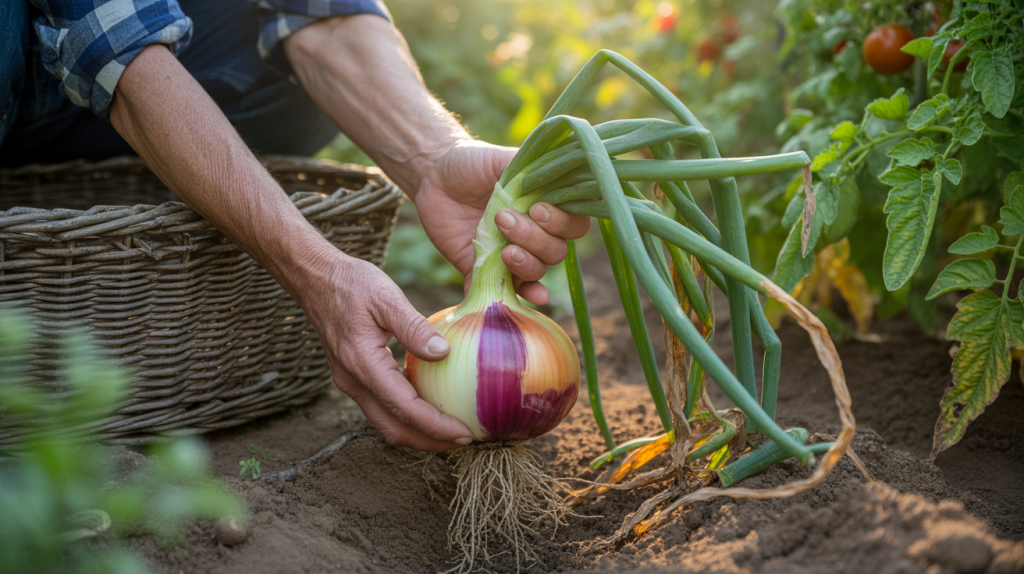
Harvest when most leaves bend down toward the ground, indicating bulb maturity. Bulbs will continue to swell and develop their proper color over the following weeks.
Use a fork or trowel to lift the onions from the soil carefully. Handle gently to avoid bruising, which can lead to storage problems and reduced shelf life.
Timing trick: Wait for 75% of tops to fall naturally this ensures maximum bulb size while maintaining storage quality.
Step 6: Curing & Storage
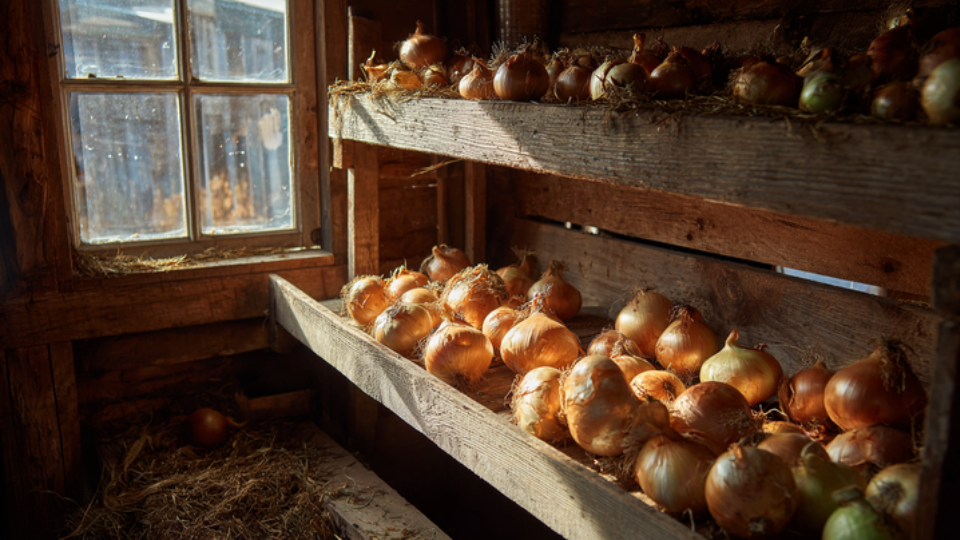
Move harvested onions under cover (in a shed, greenhouse, or a dry outdoor area) to cure for 2 weeks. Space bulbs apart on racks for good airflow, which toughens outer skins for longer storage.
After curing, store in nets, tie in bundles, or weave into strings. Properly cured onions will keep until midwinter or spring, providing months of homegrown produce.
Storage art: Learn traditional onion braiding it’s not just functional storage but creates beautiful kitchen décor that impresses guests while keeping your harvest organized.
Video Tutorial
I want to give credit to GrowVeg for their informative video, which served as a valuable reference for this guide.
Get Your Onions Right: Sun & Soil Tips You Can’t Ignore
Choose the right spot first; your onions won’t grow without proper sunlight and drainage, regardless of the variety you plant.
- Full Sun is Essential for Onion Success. Onions require 6-8 hours of direct sunlight each day to form large, well-developed bulbs. Plants grown in shade tend to stay weak and thin, resulting in poor harvests.
- Good Drainage Prevents Bulb Problems. Soggy soil kills onions by rotting their bulbs and stopping growth. Your soil should drain water within 24 hours after it rains. Here’s a simple test: dig a hole, fill it with water, and see how fast it empties.
- Clay or Wet Ground Solutions: Make raised beds 6-8 inches tall for better water flow. This lifts your onions above problem soil and lets excess water drain away properly.
- Rocky or Poor Soil Fix: Use deep containers that are at least 8 inches in diameter with high-quality potting soil. This gives you complete control over soil quality without digging up your yard.
- Small Space Growing: Try window boxes or large pots for compact onion types. You can grow onions successfully even on patios, balconies, or small garden corners.
- Test Your Soil Fast: Grab some damp soil and squeeze it tight. Does it stick together in a hard ball? Then you need raised beds. Good onion soil feels loose and falls apart in your hand when you open your fingers.
The right location sets the foundation for a successful onion harvest; compromise on sun or drainage, and even the best varieties will struggle.
Best Time to Grow Onions UK
Planting onions at the right time makes all the difference, whether you’re sowing seeds or planting sets; timing affects your harvest quality and success.
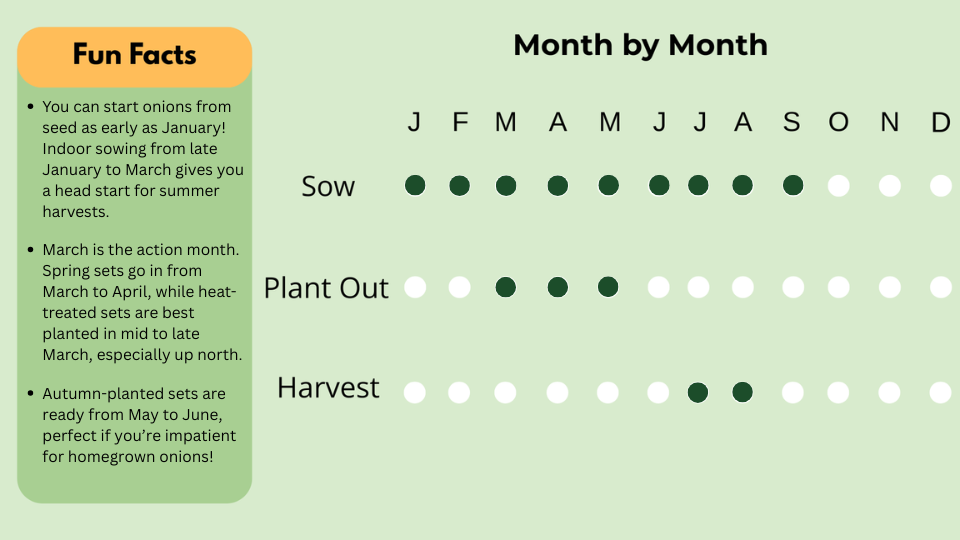
Planting onions at the right time makes all the difference, whether you’re sowing seeds or planting sets; timing affects your harvest quality and success.
Conclusion
Growing your own onions in the UK isn’t just about saving money, it’s about experiencing the satisfaction of harvesting bulbs that’ll store beautifully through winter while tasting infinitely better than shop-bought ones.
From choosing the right planting method to timing your harvest perfectly, every step I’ve shared is based on real experience in our unpredictable British climate.
The difference between mediocre and magnificent onions often comes down to small details, such as testing soil drainage, selecting heat-treated sets, or waiting until 75% of the tops have fallen before harvesting. These aren’t complicated techniques, but they distinguish successful growers from those who are disappointed.
Your garden is waiting for those impressive onion rows you’ve always admired. Start planning now, whether seeds, sets, or transplants. The most important step is getting started.
Frequently Asked Questions
What Is the Secret to Growing Big Onions?
Plant onion sets 4 inches apart, keeping the soil consistently moist. Feed with nitrogen early in the season, and harvest only when 75% of the tops naturally fall.
What Is the Easiest Veggie to Grow?
Radishes are the easiest vegetables to grow. They’re ready in just 30 days, need minimal care, and grow in almost any soil condition.
Can I Grow an Onion from an Onion?
Yes, you can grow onions from onions. Plant sprouting onions in soil or water, and they’ll produce green shoots and eventually new bulbs.
